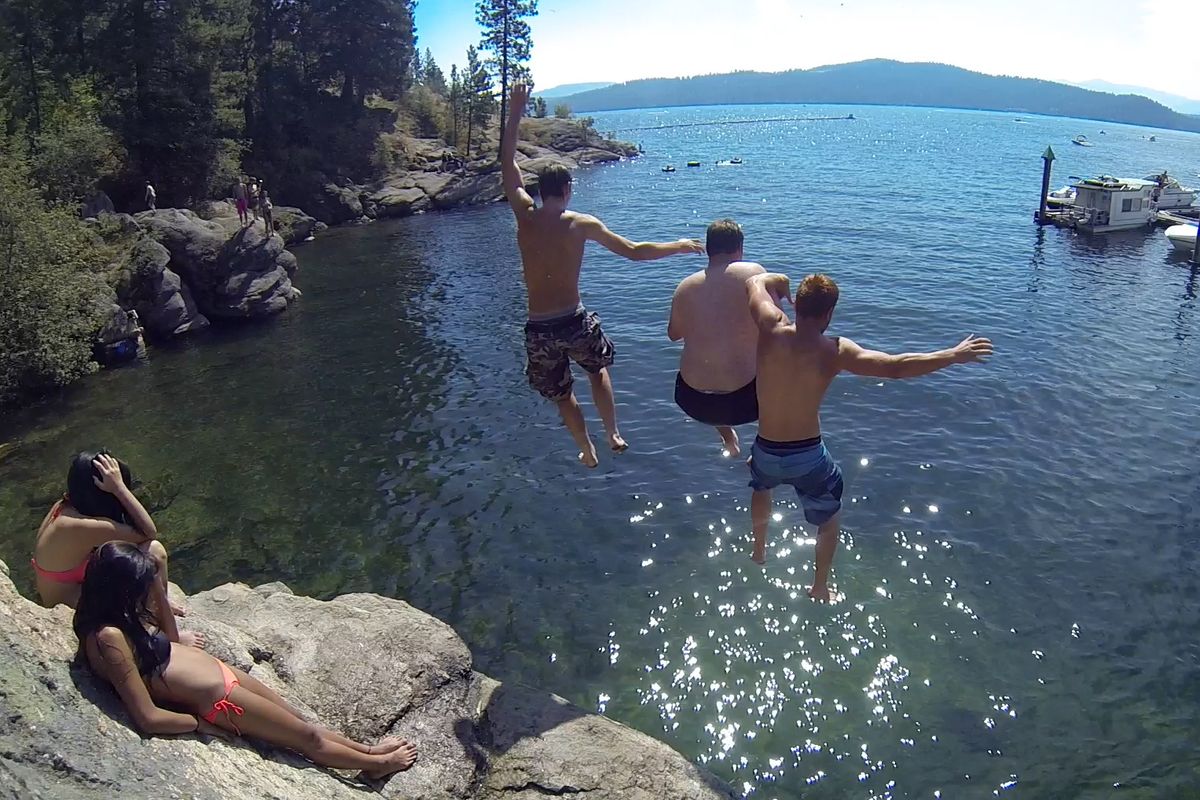Flight of passage: popular pastime at CdA’s Tubbs Hill entices thrill seekers

Brad Harrison anxiously stares downward some 25 feet to the shallow lake water below, catching his breath and gathering the courage and focus necessary to make his next jump a success.
And even though he’s made this leap of faith many, many times, he never rushes it. He knows that one slip, one brief lapse in concentration, will lead to disaster – or worse yet, death.
Adventure seekers have been jumping off the cliffs and rocks at Tubbs Hill for decades. The hill is part of the allure of Lake Coeur d’Alene for people like Harrison, who has been visiting Tubbs with family and friends since he was a young child.
“I just love it out here,” says Harrison, a 26-year-old from Spokane. “It’s peaceful … plus it’s some of the best cliffs around.”
If you grew up in the Coeur d’Alene area, you’ve probably jumped off the rocks at Tubbs Hill. But cliff jumping isn’t the only activity that takes place there. Whether it’s hiking, running, swimming or sunbathing, visitors have flocked to the hill for its adventuresome trails and to get a close-up view of one of the nation’s most beautiful lakes.
To ignore the dangers associated with this particular pastime, however, would be a mistake, and a potentially gruesome one at that.
“We don’t really encourage people to jump off the rocks,” says Bill Greenwood, interim parks director and superintendent for the Coeur d’Alene Parks Department. “I know it takes place, but it’s not one of the featured items that we believe Tubbs Hill is all about.”
Sgt. Ryan Higgins heads up the Recreational Safety section for the Kootenai County Sheriff’s Office, and although he knows jumping at Tubbs is risky, it hasn’t been a significant problem.
“In my seven or eight years with this department, I think we’ve only handled one or maybe two incidents where somebody was injured,” says Higgins. “Is it recommended? No … because you don’t know what you’re jumping into.”
For Harrison, however, the thrill outweighs the risk.
“It’s that adrenaline that’s more addicting than beating the fear itself,” he says. “Once you beat it, there’s really no reason to be afraid.”
Once he’s got his bearings, Brad Harrison meanders away from the cliff’s edge to get a running start. He must leap over 12 feet or so of protruding rocks below to even reach the 8-foot deep water. Once he’s in position, he closes his eyes for a moment, takes a deep breath and then, knowing that he must hit his mark, he takes off.
Harrison isn’t the only person atop the cliff’s edge feeling angst. A small crowd of bystanders are holding their breath in anticipation as well, and it can be an uncomfortable feeling knowing that you may be witnessing something spectacular … or something tragic.
“That’s dangerous just because of all the stuff underneath if you don’t clear it,” says Coeur d’Alene’s Thomas Hoctor, 24, who was hanging out with some friends to watch the action. “That’s why you don’t see many people jump it, because you have to clear everything underneath.”
This time, the daredevil hits his mark. As he flies through the air, he flips and twists and then, facing the perfectly solid ground he occupied just a moment earlier, he enters the water feet first and clear of danger.
“Since I’ve been here so long, I know these rocks pretty well,” Harrison says.
Despite his intrepidity, Harrison understands the hazards associated with this extreme sport all too well. A few years ago, he was hospitalized for more than a week with a broken back, injuries he suffered while jumping off the rocks at Donkey Island in the Spokane Valley.
But on this day, his attention rests in the the adrenaline rush.
“You’ve got to go bigger, you’ve got to go better – just get way out there. The more you can do it, the better it feels.”